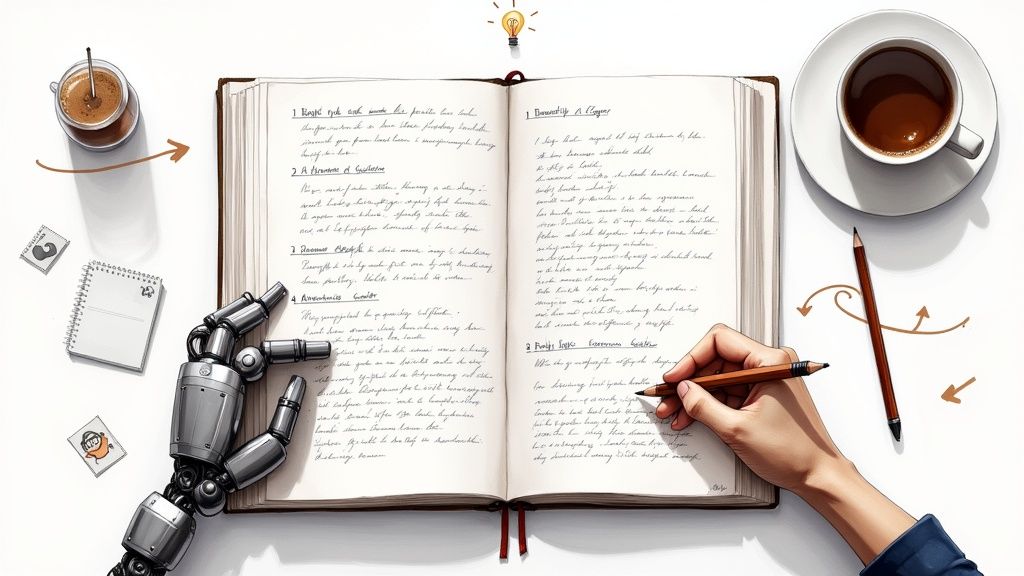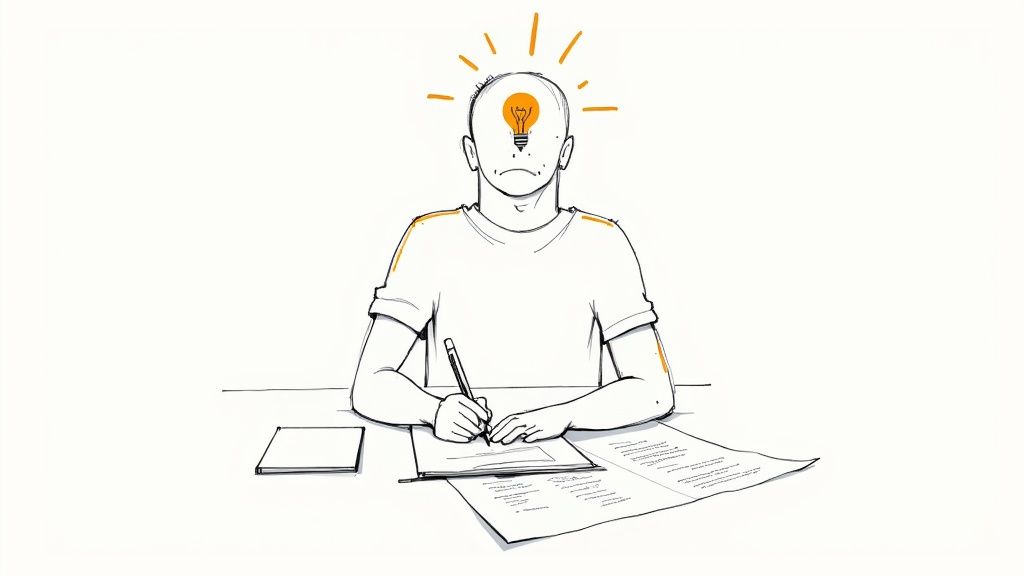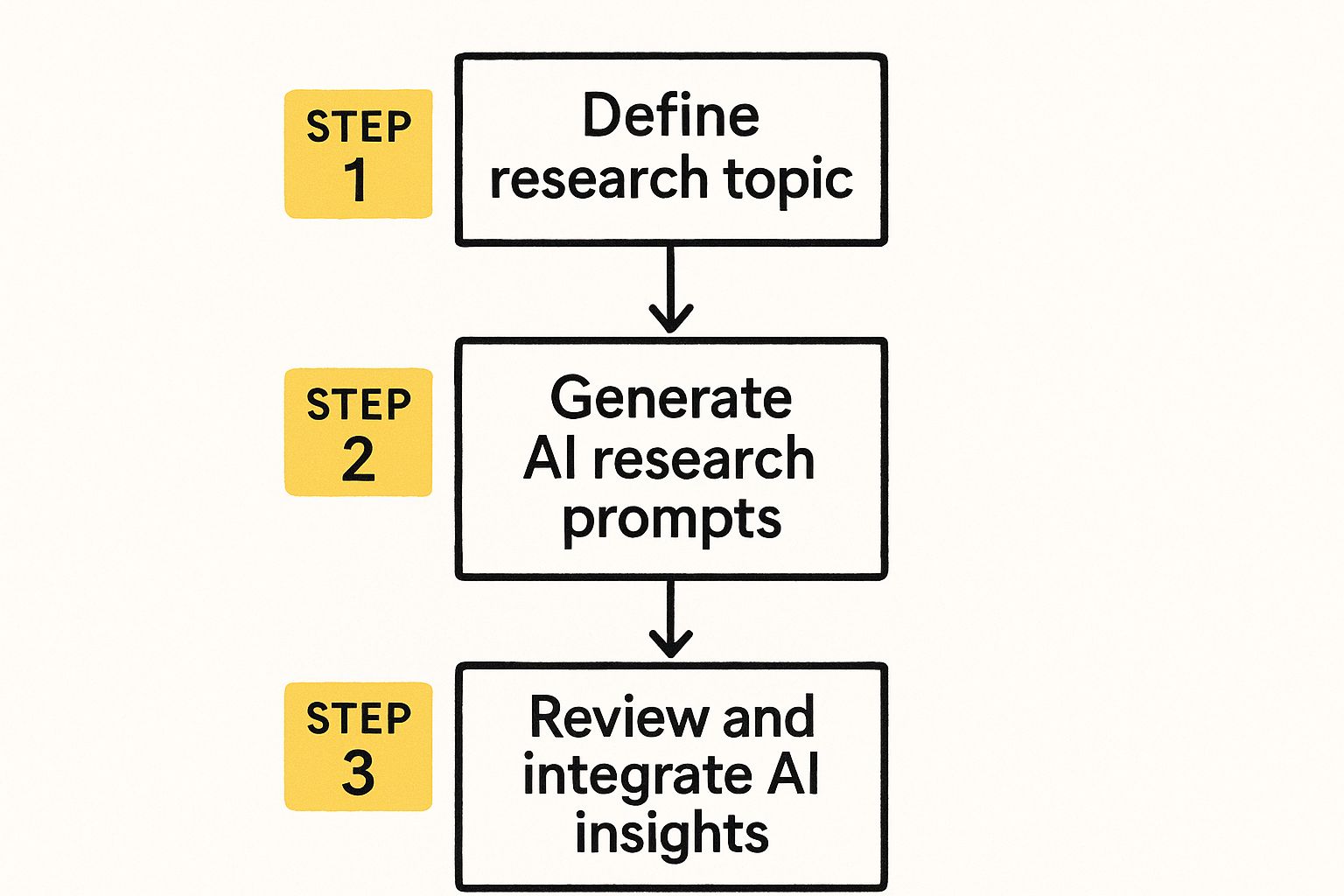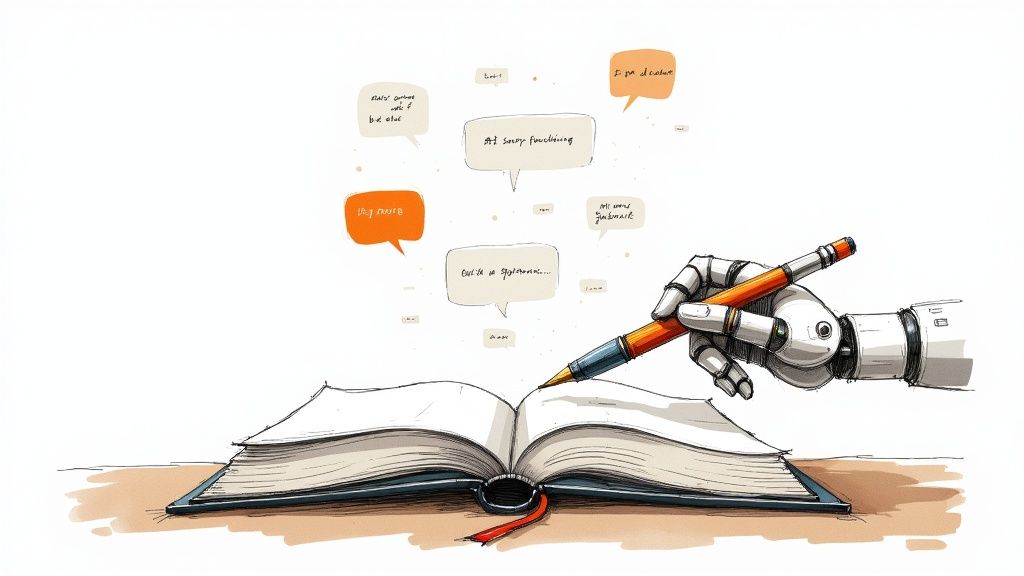How to Use AI to Write a Book

📖 Complete Publishing Workflow: This guide focuses on the writing phase. To see how AI writing fits into the complete book publishing process—including editing, cover design, and marketing—explore our Complete Guide to AI-Powered Book Publishing.
So, you're thinking about using AI to help write a book? It's a fascinating idea, and not nearly as sci-fi as it might sound. The process is really a human-led effort where you're in the driver's seat. You guide the AI to brainstorm, outline, draft, and polish your manuscript.
Think of yourself as the creative director and the AI as your incredibly fast, tireless assistant. It handles the heavy lifting of getting words on the page, but you're the one with the vision. It's a partnership, not a replacement for your own creativity.
Meet Your New AI Writing Partner

Welcome to a new era of writing. Here, artificial intelligence isn't just a gadget—it's your collaborator. The thought of an AI co-authoring a book can seem a bit much, but it really just boils down to a simple partnership: you provide the vision, and the AI handles the mechanical work.
Let go of the image of a robot single-handedly penning a bestseller. It doesn't work that way. Instead, see AI as a junior partner that can help you brainstorm plot twists at 3 AM, structure your entire story, or pump out a rough first draft when you’re staring at a blank page. This guide will walk you through a practical, human-led workflow that always keeps you in control.
The Human-in-the-Loop Approach
The only truly effective way to work with AI is by using what's called a human-in-the-loop model. This just means you’re actively involved every step of the way, from the first spark of an idea to the final, polished manuscript. You bring the creativity, the unique perspective, and the critical judgment that machines simply don't have. The AI brings the speed and scale.
Working together this way allows you to:
- Generate Ideas on Demand: Stuck? Ask an AI for a list of character arcs, potential plot points, or vivid setting descriptions to get the creative juices flowing again.
- Build a Rock-Solid Outline: Give the AI your core concepts, and it can help you build a detailed, chapter-by-chapter blueprint for your book.
- Draft with Unprecedented Speed: Use that outline to prompt the AI to write individual scenes or chapters, giving you a solid foundation that you can then edit and infuse with your own voice.
This was never about letting a machine take over. As any writer will tell you, the real magic happens in the "making of the thing"—in the thousands of tiny decisions that shape a story. AI just helps you make those decisions faster.
The bottom line is simple: You are the author; the AI is your apprentice. It executes the tasks you give it, but it can’t replicate your unique voice or emotional depth. The final book is a product of your creativity, amplified by technology.
A Quick Look at the Tech Behind the Tool
Before we jump into specific tools, it’s useful to have a basic grasp of the broader field of Artificial Intelligence that makes all this possible. Most AI writers are powered by Large Language Models (LLMs), which are complex systems trained on staggering amounts of text from the internet.
This massive training allows them to understand patterns, context, and grammar, enabling them to generate text that feels remarkably human. When you use an AI writer, you're not just pulling a pre-written story off a shelf. You're interacting with a system that assembles words based on statistical probabilities and, most importantly, the specific instructions—or prompts—you provide. The better your prompts, the better the output.
This is a critical point because it puts the responsibility for the book's quality squarely on your shoulders. You’re not a passive user; you're the director, turning the lonely act of writing into a dynamic, collaborative process.
Choosing the Right AI Writing Tool
The very first, and arguably most important, decision you'll make on this journey is picking the right AI tool. This isn't just a technical choice; it's about selecting a creative partner that will fundamentally shape how you write your book. The market is absolutely flooded with options, and your job is to find the one that truly clicks with your genre, your personal writing style, and how you actually get work done.
Think of it this way: a fantasy novelist weaving an epic saga has completely different needs from someone writing a practical business guide. The tool you choose will influence everything—from initial brainstorming and character consistency to the final narrative voice of your manuscript.
Specialized Platforms vs. General LLMs
Your first major fork in the road is deciding between a platform built specifically for authors and a more general-purpose language model. For a comprehensive comparison of 15+ AI writing tools with detailed reviews, pricing, and use cases, see our complete guide to the best AI tools for authors.
Comprehensive Platforms (e.g., Sudowrite): These are the tools built by writers, for writers. They come packed with features designed for storytelling, like plot management, character development trackers, and tools for generating evocative prose. They're like a dedicated writing studio with AI assistants ready for specific tasks.
General LLMs (e.g., GPT-4, Claude): These are the powerhouses. They're incredibly flexible and can tackle almost any writing task you throw at them. Their strength is raw versatility, but they lack the built-in, story-focused features you'd find in a specialized tool. You'll need to be much more hands-on with your prompting and organization.
So, how do you choose? It really comes down to your preferred workflow. If you want a structured environment that guides you through the narrative process, a specialized platform is probably your best bet. If you thrive on a blank canvas and want total control over a powerful engine, a general LLM might be a better fit.
Key Features to Look For
When you start comparing options, don't get bogged down by flashy marketing. Focus on the practical features that will actually help you write a book.
Your goal is to find a digital partner that enhances your creative process, not one that hinders it with a steep learning curve or mismatched features.
Here are the non-negotiables I always look for:
- Tone and Style Control: Can the AI learn from your writing? Can you feed it examples to match your authorial voice? The ability to guide the AI’s tone is what separates a generic, robotic draft from a book that sounds like you.
- Character Consistency: This is a big one for any long-form project. Does the tool have a "story bible" or character-tracking feature? Keeping character traits, voices, and backstories straight across 80,000 words is a massive challenge that the right AI can help you solve.
- Plotting and Structure Tools: I always look for features that help with outlining, mapping story beats, or even following classic structures like the three-act model. This is your guardrail, keeping the narrative from veering off course.
For a deeper dive, check out our detailed breakdown of the 7 must-have AI writing tools for authors, where we explore specific platforms and their capabilities.
Once you've chosen your AI writing assistant, you'll also want robust organizational software to manage your manuscript. If you're looking for alternatives to traditional tools like Scrivener, our guide to the best Scrivener alternatives for fiction writers covers 12 options including 7 completely free tools perfect for pairing with AI assistance.
The image below shows a simple but effective way to think about incorporating AI into your research—a crucial step for both fiction and non-fiction.

What I love about this workflow is that it puts the author firmly in the driver's seat. The AI is there to generate possibilities, but you are the one curating, fact-checking, and weaving those ideas into a cohesive narrative.
AI Writing Tool Feature Comparison
To help you visualize the differences, here's a quick comparison of what you can generally expect from each type of tool.
| Feature | Comprehensive Platforms (e.g., Sudowrite) | General LLMs (e.g., GPT-4, Claude) | Specialized Tools (e.g., Plottr AI) |
|---|---|---|---|
| Primary Use Case | All-in-one manuscript creation from brainstorming to drafting | Highly versatile, good for dialogue, brainstorming, research, and general writing tasks | Focused on a single aspect of writing, like outlining or plotting |
| Story Bible/Consistency | Built-in feature to track characters, locations, and lore | Requires manual prompting and context management; can "forget" details in long conversations | Not its primary function, but the outline itself helps maintain consistency |
| Plotting & Outlining | Integrated outlining and story structure templates (e.g., three-act, hero's journey) | Can generate outlines based on prompts, but lacks a dedicated interface | This is its core strength; offers visual and structured plotting environments |
| Learning Curve | Moderate; need to learn the platform's specific tools and interface | Low to high; easy to start, but advanced prompting requires skill | Low; designed to be intuitive for its specific task |
| Cost | Typically a monthly subscription ($10 - $30/mo) | Varies from free tiers to monthly subscriptions or pay-as-you-go models ($20/mo+) | Often a one-time purchase or a lower-cost subscription ($25 - $150) |
This table isn't exhaustive, but it should give you a good starting point for figuring out which category of tool best matches your immediate needs for your book project.
Making Your Final Choice
There's no magic formula here. The "best" tool is intensely personal. The key is to take full advantage of free trials. Really put them through their paces for a week. Use prompts directly related to your book idea and see what you get back. Read recent reviews from authors in your genre—their real-world experience is invaluable.
While our guide focuses on writing a book, many of these skills are transferable. If you’re curious about a broader academic perspective, you might find this guide on the top AI tools for students that can assist with writing and research useful.
Ultimately, you're looking for something that feels less like a machine and more like an extension of your own mind—a co-pilot that helps you tell your story more effectively without ever getting in your way.
Building Your Book's Blueprint with AI

Every great book is built on a solid foundation. Before you even think about writing that first chapter, you need a detailed blueprint. I’ve found that an AI can be an exceptional partner during this architectural phase, helping you turn a vague concept into a structured, scene-by-scene roadmap that will guide the entire project.
This isn't about handing over the reins and letting the AI invent your story. Far from it. Think of it as an interactive sounding board—a way to test ideas, organize your narrative, and patch up the kind of plot holes that can sink a manuscript halfway through. The real goal here is to construct a framework so robust that you can start drafting with total confidence.
From Core Idea to a Compelling Logline
It all begins with that one, powerful idea. But how do you distill that flash of inspiration into something concrete? You start with a logline, which is just a one or two-sentence summary that captures the very soul of your story. AI can be a game-changer for this.
Instead of a lazy prompt like "give me a logline," you need to feed the AI the core ingredients. Let's say you're working on a sci-fi novel. A much better prompt would be:
"Generate 5 compelling loglines for a sci-fi story about a disgraced starship pilot who discovers a galaxy-threatening conspiracy. The only evidence is locked in the memory of her malfunctioning android co-pilot. The tone should be a mix of gritty noir and classic space opera."
That level of detail is what pushes the AI beyond cliché and toward nuanced options you can actually use and refine. Your logline becomes your North Star, a constant reminder of the story's central conflict and its promise to the reader.
Architecting Your Plot with Classic Structures
With a solid logline in hand, the next move is to flesh it out into a full plot. Rather than asking the AI to simply "write a plot," guide it with a proven narrative structure. The three-act structure is a timeless classic for a reason; it provides a clear beginning, middle, and end.
Here’s how you can prompt your AI to apply this framework to your idea:
- Act I (The Setup): Ask the AI to brainstorm an inciting incident. What kicks the story off and forces your hero into action? For our pilot, this might be the moment she stumbles upon a coded message during what should have been a routine cargo run.
- Act II (The Confrontation): Prompt the AI to develop the rising action and a major midpoint twist. What obstacles does the pilot face? How does the conspiracy fight back? The midpoint could be the android co-pilot getting stolen, leaving her with zero proof.
- Act III (The Resolution): Finally, use the AI to map out the climax and the story's conclusion. How does she ultimately expose the conspiracy and clear her name?
This structured brainstorming transforms a simple idea into a coherent narrative arc, giving you a solid skeleton for your book.
Breathing Life into Your Characters
A killer plot falls flat without compelling characters. This is another area where I've seen AI shine as a brainstorming partner. You have to go beyond simple descriptions and use prompts to build rich, three-dimensional characters with real motivations.
For our disgraced pilot, Kaelen, you could prompt the AI with something like this:
- "Create a detailed character profile for a starship pilot named Kaelen. Give her a backstory that explains why she was disgraced, a deep-seated fear that drives her decisions, and a secret she's hiding from everyone."
- "Develop a personality for her android co-pilot, Unit 734. What are its quirks? Does it have a 'personality' flaw that makes it unreliable but also strangely endearing?"
This process gives you so much more than names and job titles. It provides the psychological depth needed to write characters that feel like they could walk right off the page.
A detailed outline isn't a cage; it's a map. It gives you the freedom to explore creative detours during the drafting phase without getting hopelessly lost. Building this map with an AI from the start helps ensure your story stays coherent and compelling from beginning to end.
This kind of collaborative outlining is quickly becoming standard practice. In fact, industry data shows that 71.7% of writers already use AI for outlining, which really highlights how effective these tools are at the foundational stage. You can dig into more fascinating stats on AI's role in writing in The Novelist Studio's 2025 writer survey.
By using AI to build your book's blueprint, you're not just saving time; you're stress-testing your story's architecture before you lay the first brick. This front-loaded effort pays off big time, leading to a tighter manuscript and a much, much smoother drafting experience.
Drafting Your Manuscript with Your AI Assistant
Alright, this is where the magic happens. Your detailed blueprint is about to become the living, breathing heart of your book—the first draft. It's time to shift from planning to actually writing, and your AI assistant is ready to be your tireless partner.
The success of this entire phase really comes down to one thing: mastering the prompt.
Think of yourself as a film director. You don't just tell your actors to "act." You give them context, motivation, and specific beats to hit. It's the exact same principle here. You'll be feeding your AI the outline, character notes, and the specific tone you're after to produce prose that actually matches your vision.
The goal is a fluid, back-and-forth collaboration. You generate content piece by piece, which keeps you firmly in creative control and lets you make adjustments on the fly. Let's get practical.
The Scene-by-Scene Generation Method
It's tempting to throw a huge prompt at your AI, like, "Write chapter one." Trust me, that's a recipe for disaster. You'll almost always get generic, rambling text that completely misses the mark. A much better way is to break your chapter down into individual scenes and generate them one at a time. This keeps you in the director's chair.
For each scene, you'll put together a "prompt package" with all the essential information. This gives the AI the guardrails it needs to do a good job.
Here’s what I've found works best for a strong scene prompt:
- Context: Give it a quick "Previously on..." to set the stage. For example, "Kaelen just escaped the security patrol on Neo-Sector 7 and is hiding in an abandoned cargo bay."
- Scene Goal: What's the point of this scene? What absolutely has to happen? "The goal is for Kaelen to discover a hidden compartment in her android's chassis containing a data chip."
- Character and Tone: Specify the point of view and the emotional vibe. "Write this from Kaelen's POV. She's exhausted, paranoid, and desperate. The tone should be tense and claustrophobic."
- Key Actions: List the 3-5 most important beats that must occur. "1. She scans the bay for threats. 2. Her android, Unit 734, makes an unusual clicking sound. 3. She investigates and finds the loose panel. 4. She pries it open and finds the chip."
When you provide this much detail, you're not asking the AI to invent the story; you're asking it to render the story you've already designed. The result is so much more specific and useful.
Human authorship isn't about typing every single word; it's about making every creative decision. The real art is in the thousands of tiny choices—the word selection, the pacing, the emotional beats. Your job is to make those decisions and use the AI to execute the heavy lifting.
Keeping Character Voices Consistent
One of the biggest hurdles I've seen when using AI for a full book is keeping characters consistent. An AI can easily forget a character's unique way of speaking or their core personality traits over the course of 50,000+ words. This is where your detailed character profiles become invaluable.
Before you generate a scene, you need to refresh the AI's "memory."
A great habit to get into is starting your prompt with a little character refresher:
"I'm writing a scene with my protagonist, Kaelen. Remember: She's a cynical ex-pilot who uses dry sarcasm to hide her fear. She speaks in short, clipped sentences and rarely shows vulnerability. Now, write the following scene..."
This simple step acts as a constant anchor, preventing that dreaded "voice drift" where all your characters start sounding like the same person.
The Write, Review, Refine Loop
You have to treat the AI's output as what it truly is: a first pass. Never, ever just copy and paste it directly into your manuscript without a thorough review. This is where your human touch is absolutely non-negotiable.
- Generate a Scene: Use that detailed prompt package you built.
- Review the Output: Read through what it gave you. Did it hit the key actions? Is the tone right? Does the dialogue sound like something a real person would say?
- Refine and Edit: Now it's your turn to write. Fix the awkward sentences. Punch up the emotional impact. Add the sensory details that AI always misses—the sharp smell of ozone in the cargo bay, the cold, smooth feel of the data chip. This is where you pour your soul into the text.
This loop—generate, review, refine—is the fundamental workflow for drafting with an AI. It's a dance between you and the machine. To make the "refine" step even faster, you can leverage speech-to-text functionality within AI tools like ChatGPT and simply dictate your edits and new ideas.
This human-led process ensures the final manuscript is truly yours. You are the one weaving the narrative, making the creative calls, and adding the nuance that a machine just can't replicate. The AI is simply the most advanced typewriter ever invented.
Refining and Editing Your AI-Generated Draft

Let's be clear: an AI-generated draft isn't a book. It's the raw clay, the block of marble before the sculptor gets to work. This is where you, the author, step in. The process of transforming that functional but often flat text into a compelling manuscript is where the real artistry happens.
This is your moment to earn your author title. Your job is to take the AI's technically correct but frequently soulless output and breathe life into it. This means injecting genuine emotion, layering in rich sensory details, and letting your unique authorial voice shine through.
Elevating the Human Element
The biggest giveaway of an AI draft is its lack of soul. While a machine can follow a plot outline, it can't truly convey what it feels like to be human. Your first editing pass should be dedicated entirely to adding that human touch.
- Emotional Resonance: Pinpoint the moments where your reader should feel a surge of joy, a pang of heartbreak, or a knot of tension. Rework those scenes. Don't just tell the reader a character is sad; show it in their slumped shoulders, their quiet withdrawal, or the way they interact with the world.
- Sensory Details: AI rarely fills a scene with the kind of specific, immersive details that pull a reader in. You need to add the smell of rain on hot asphalt, the rough, worn texture of a character's favorite jacket, or the specific, musical pitch of their laugh.
- Authorial Voice: This is your signature—your rhythm, your humor, your worldview. Read every single sentence out loud. Does it sound like you? If it doesn't, rewrite it until it does. This is the single most important step in claiming the work as your own.
An AI can generate a thousand pages, but it can't replicate a single human experience. The magic is in the making of the thing, in the tiny, deliberate choices you make with every word. That’s the art, and it cannot be replicated by a machine.
This partnership between writer and machine is becoming the new normal. By 2025, many see the ideal collaboration as one where AI handles the heavy lifting of drafting and consistency, freeing up human writers to provide the essential creative vision, emotional depth, and ethical oversight. You can explore this evolving dynamic further in this resource from Yomu.ai.
The Structural and Factual Edit
After you've infused the draft with humanity, it’s time to put on your technical editor hat. AI is notorious for getting things wrong, from minor continuity slips to glaring factual errors. Never, ever trust the AI's output without a thorough check.
Think of this as reviewing the manuscript's skeleton.
- Pacing and Flow: Does the story sag in the middle? Does the climax feel rushed? You’ll likely need to expand some scenes to build tension and condense others to keep the story moving.
- Plot and Character Consistency: Did your hero's eyes mysteriously change from blue to green in Chapter 12? Does a crucial clue appear before the characters could have possibly discovered it? Track these details like a detective, because the AI certainly won't.
- Fact-Checking: This is non-negotiable for non-fiction. Verify every single statistic, date, and claim. For fiction, it means ensuring the internal logic of your world—whether it's a fantasy kingdom or a modern-day city—remains consistent.
This phase is less about creative flourishes and more about building a solid, credible foundation. It’s the structural work that allows your creative elements to truly stand out.
Streamlining the Final Polish with AI Tools
Once you’ve done the heavy lifting of the creative and structural edits, you can bring technology back into the fold for the final polish. This is where AI editing and proofreading tools are incredibly powerful.
Think of these tools as super-powered assistants, not replacements for your judgment. They excel at catching the tiny mistakes human eyes tend to gloss over after reading the same text for the tenth time. Our own guide on choosing an AI tool for book editing offers a deep dive into some of the best options out there.
These programs can quickly flag:
- Grammar, spelling, and punctuation errors
- Repetitive words and awkward phrases
- Sentences that are convoluted or unclear
Using an AI for this final, mechanical pass frees up your brainpower. It lets you stay focused on the big-picture storytelling, confident that the small-scale technical details are being handled. This human-AI partnership—with you as the creative director and the AI as your meticulous assistant—is the smartest way to write a book today.
Answering Your Questions About Writing a Book with AI
Whenever I talk to authors about using AI in their writing, the same handful of questions pop up. And they're good questions—important ones. It’s a new frontier, and it’s smart to be cautious and curious. You're not just wondering if it's possible; you're asking if it's wise.
This isn't about ignoring the tricky parts. It's about getting straight, practical answers so you can decide how, or even if, these tools fit into your creative workflow. Let's dive into the big ones.
Can I Actually Copyright a Book I Wrote with AI?
This is the million-dollar question, isn't it? The short answer is yes, but it's not a simple checkbox. The key phrase from the U.S. Copyright Office is "substantial human authorship."
You can't just copy-paste from an AI and slap your name on it. That won't fly. What you can copyright is the unique work you create with the AI as a tool. Think of it this way—your copyright covers:
- The parts of the book you wrote entirely on your own.
- Your specific choices in selecting, arranging, and heavily editing the AI's suggestions.
- The creative, detailed prompts you wrote to guide the AI in the first place.
Essentially, the copyright office needs to see that a human was the creative mind behind the finished book. Your job is to be the author, the editor, and the creative director. The more you revise, rewrite, and infuse your own style, the stronger your claim to authorship becomes.
Will My Writing End Up Sounding Like a Robot?
This is a very real concern. Left to its own devices, AI tends to drift toward the average, producing prose that’s often bland, predictable, and utterly soulless. It works with patterns, not lived experience.
The best way to avoid a generic tone is to treat the AI as an assistant, not the author. Your voice is the most important thing you bring to the page, and your job is to make sure it shines through.
A generic output is usually a sign of a generic input. Vague prompts get you vague writing. The more specific you are—giving the AI notes on tone, showing it examples of your style, and detailing character motivations—the better the raw material it will give you. But the real work begins when you take that draft and start rewriting, polishing, and breathing your own life into it until it sounds undeniably like you.
What Are the Biggest Mistakes People Make?
From what I’ve seen, the most common missteps fall into two camps: relying on the AI too much and not editing enough.
The absolute biggest mistake is treating the AI's first draft as a finished product. You have to put on your most skeptical editor hat and dig in. That means you need to:
- Fact-Check Absolutely Everything: AI models are notorious for "hallucinating"—making up facts, sources, and historical details with complete confidence. This is a deal-breaker for non-fiction, but it's just as important for keeping your fictional world consistent.
- Add the Human Layer: An AI can give you a plot. It can't give you a soul. Your job is to weave in the emotional depth, the sensory details, the subtext, and the nuance that a machine simply can't replicate.
- Stay in Control of the Story: Don't let the AI take the reins. You're the author. Your outline and your vision must be the ultimate authority, ensuring the plot and characters stay true to the story you want to tell.
Avoiding these traps is key. For indie authors especially, figuring out this human-AI partnership is critical for success. We explore the complete workflow and unique challenges in our comprehensive guide to AI-powered book publishing. In the end, it all comes down to using the technology to boost your own creativity, not to replace it.
Ready to transform your manuscript into a polished, market-ready asset without the guesswork? Let ManuscriptReport.com do the heavy lifting. Our AI-powered reports generate everything from blurbs and ad copy to social media posts and keywords in minutes, saving you dozens of hours so you can focus on writing your next book. Get your comprehensive marketing report at https://manuscriptreport.com.
